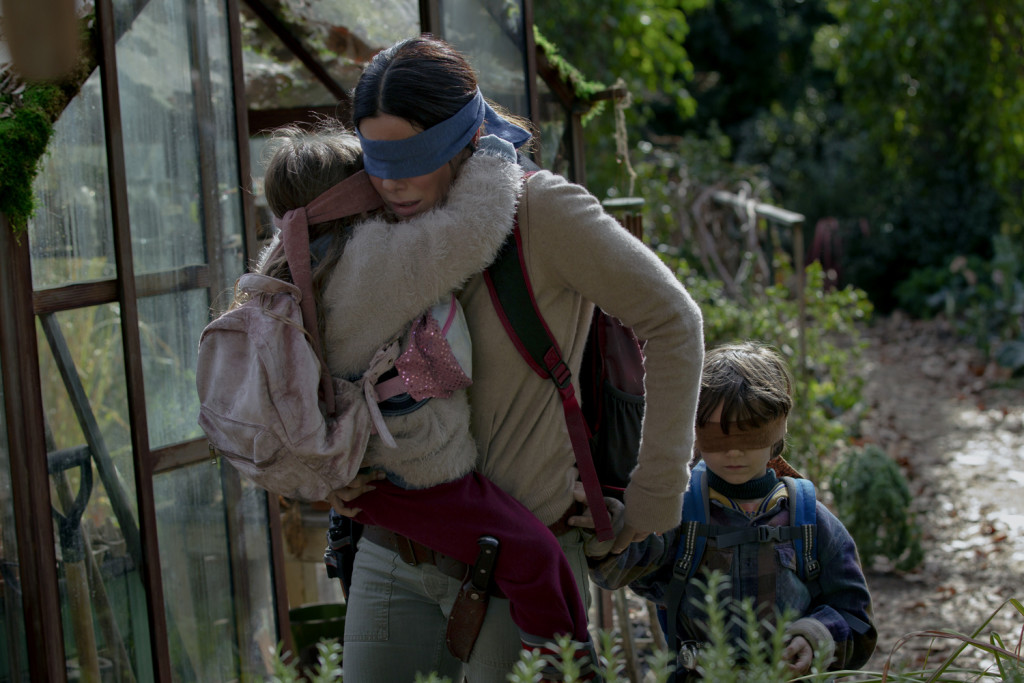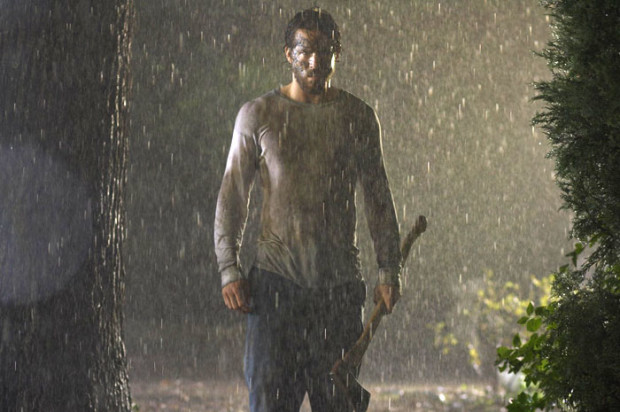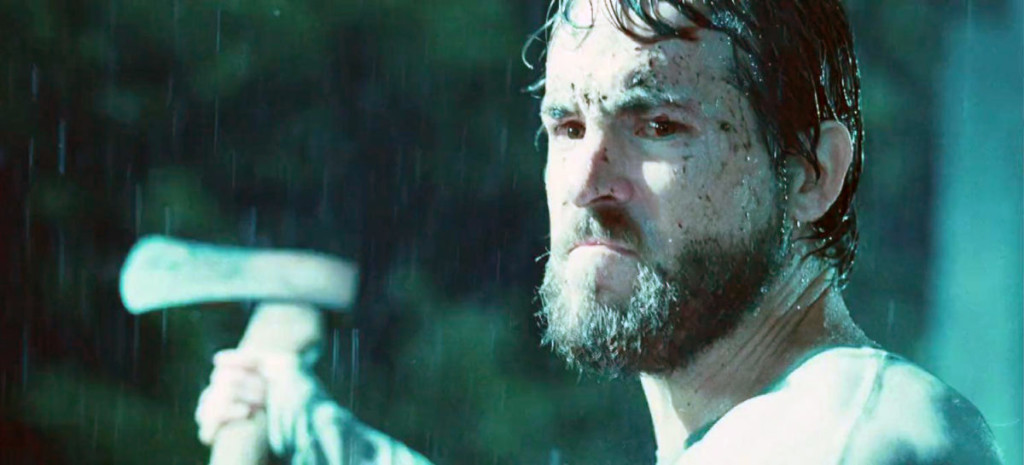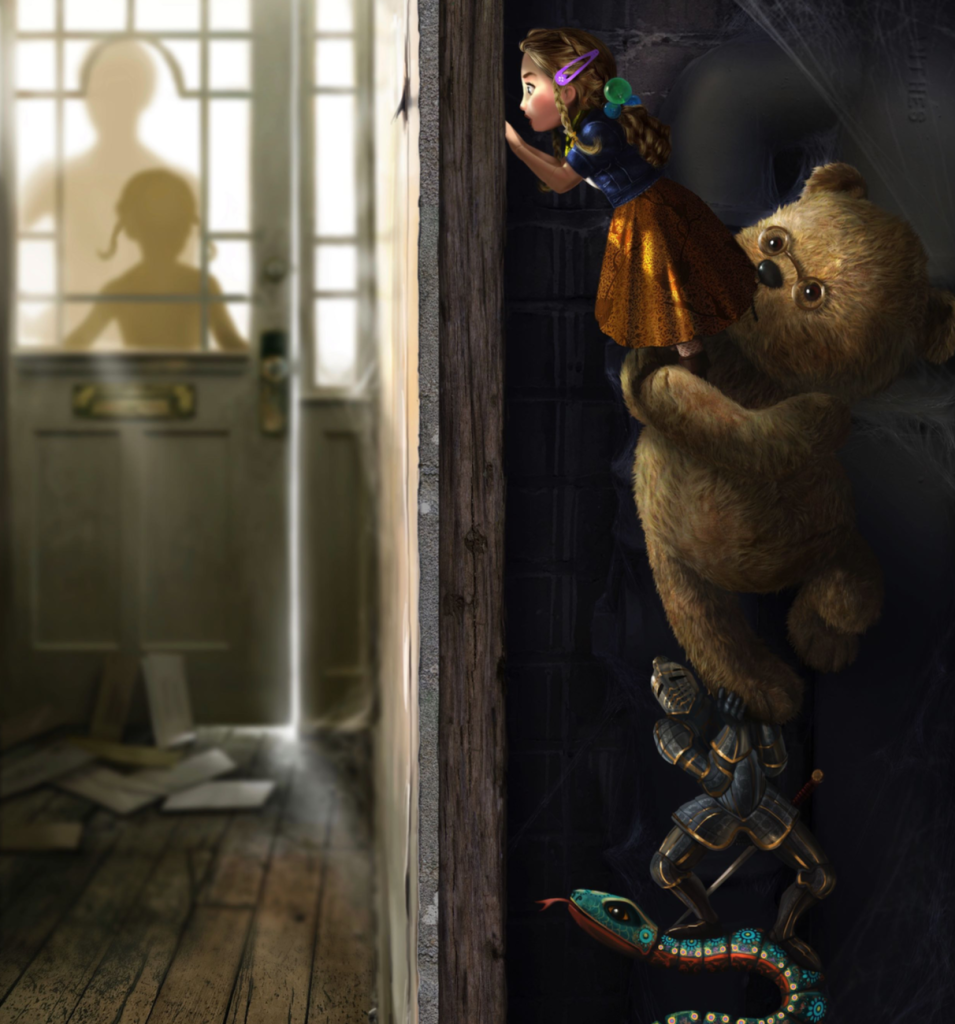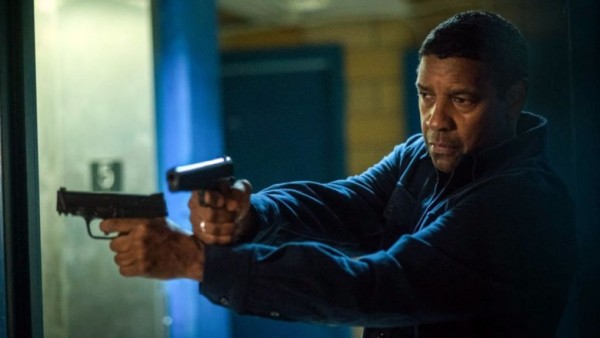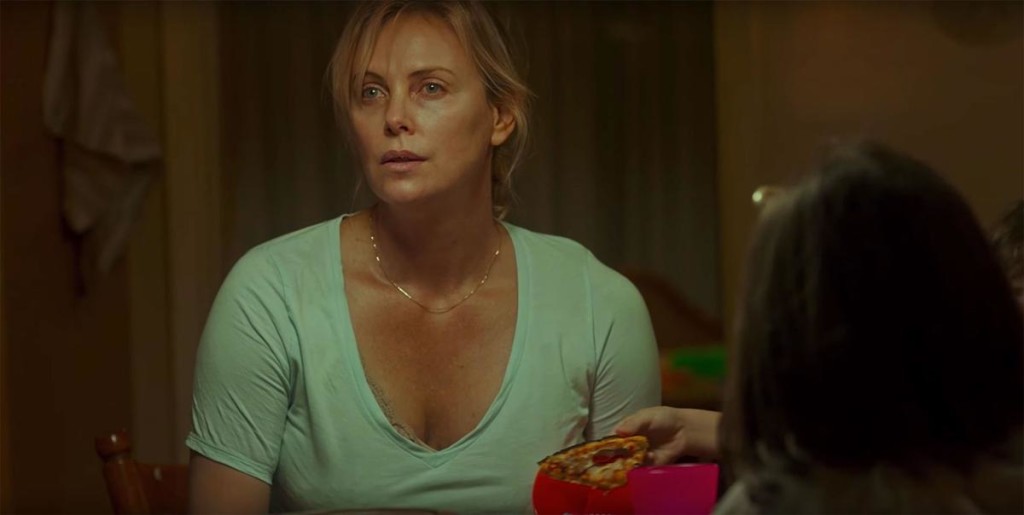Search Results for: the wall
Genre: Horror
Premise: (from IMDB) Five years after an ominous unseen presence drives most of society to suicide, a mother and her two children make a desperate bid to reach safety.
About: Bird Box started off as a novel. Screenwriter Eric Heisserer (Arrival) actually began adapting the novel before it was finished. How early on was this adaptation process? Heisserer would occasionally call Josh Malerman to see if it was okay to add something here or there in the movie, to which Malerman would reply, “Ooh, that’s good. Can I put that in the book?”
Writer: Eric Heisserer (based on Josh Malerman’s novel)
Details: 2 hour running time
It’s been a long time since I read the script for Bird Box but I remember liking it a lot. And not just for its concept. The script’s central idea – not being able to look at the monsters – was a brilliant way to keep the movie cheap. If the characters don’t see them, neither do we, and that means you get an expensive monster movie without having to create expensive monsters. And it’s not only that. Much of what scares people in horror movies isn’t the actual monster, but the threat of the monster, which is why you can get away with showing so little for so long. That’s the theory, anyway. Did this approach work for Bird Box? Let’s find out.
Bird Box had one of the best openings to a film all year. If we’re being honest, it’s hard to screw “world falling apart” openings up. Even the most basic imagery – people running for their lives, screaming, violence, chaos – is exciting to watch. But that’s been the problem as of late. Directors have been showing that and only that, and it’s gotten a bit stale. Susan Bier’s choices here feel much more intense, such as a random woman in the hospital banging her bloody head against the window than staring down the pregnant Malorie. Or Malorie’s sister, who’s trying to escape this chaos, driving them away before *seeing* one of these things, only to switch into suicide mode, weaving the car in and out of traffic while Malorie attempts to stop her. It was not only incredibly intense, but it brilliantly set up the movie’s hook – DON’T LOOK.
From there, Bird Box switches to a cross-cutting structure that stuffs Malorie into a suburban house with ten other characters right after the event, then occasionally cuts to five years later, where Malorie and two young children are attempting to navigate a boat down a river while all three are blindfolded, representing the new reality for anyone who survived the initial event. The three are attempting to get to a bunker full of people, which is conveyed via an opening radio voice over of a man explaining where the bunker is and how to get there.
So how did the movie hold up? Was it as good as the script?
For a good portion of the film, yes. Especially the first half. There was a genuine excitement born out of what just happened, not completely understanding the threat, and needing to learn the rules. John Malkovich is such a great actor and his unique personality brought an energy to the early house scenes that ensured we were always entertained.
From there, the first script change arrived (or at least, I don’t think this was in the script – maybe someone can confirm this). Bier and Heisserer expanded the mythology so that instead of only needing to see the monsters to turn suicidal, certain people would become influencers, tricking humans into believing it was okay to look, encouraging them to take off their blindfolds, only for it to be a lie. The duped party would see the monster and then commit suicide.
I understood why they did this. When you need to keep your eyes closed to live, you keep your eyes closed. Even if someone were to rip your blindfold off, you could still just shut your eyes. This way, there was an added threat. Especially because these “influencers” would pretend to be normal people. For the most part, this worked, as it led to two of the more exciting scenes in the film (a man trying to get inside of the supermarket and a man attacking the boat). It made the mythology a little murkier, but overall it was a clever choice.
Bier made a couple of choices that hurt the film, though. For starters, she placed these characters in a giant beautiful house. Not only that, but the inhabitants covered the windows with a series of perfectly crafted rainbow-esque paper, casting a beautiful spectrum of colors across the walls and characters at all times. It was in stark contrast to the dark dreary hopeless house that was painted in the script. And it wasn’t just that. It feels like more characters were added. Too many. This gave the big bright perfectly lit house a party atmosphere. I was supposed to feel scared. Instead I wanted to go out clubbing.
The critical moment for Bird Box came about 70% of the way into the film. A few scenes after letting a new member into the house, a middle aged British business man, we learn that he’s actually an influencer. He begins spouting his demon rhetoric and ripping the covering off all the windows, forcing everyone to look. One by one, all of the people start dying. If there were a meter on the side of every movie telling you, on a scale from 1 to 10, how well the current scene was working, the meter would’ve been at a 3 here. For the first time, it became evident that Bird Box’s conceit of never seeing the monsters was hurting it. This moment was the culmination of the pervious 70 minutes. It needed to be big. It needed monsters. Instead, we got a mildly threatening British man yelling a bunch of gibberish.
Another issue I wish they would’ve hashed out was the relationship between Malorie and the children. It was so cold as to be nonexistent. The reason this is a big deal is because the entire emotional thru-line of the 5 Years Later storyline is built on the connection between Malorie and those children. If you look at the major comp for Bird Box, A Quiet Place, that film put a ton of focus on establishing a connection between the parents and the children. Here they assume we’ll do that work for them, and that’s always a dangerous game to play. I never got the sense that Malorie had a connection to these two kids. I feel like that could be its own TV show – Assumptions In Screenwriting. It would cover assumptions writers make and the disastrous effects of doing so.
With that said, Bird Box is better than most of the movies Netflix makes. It’s stylish. It’s got big budget production values. The acting is strong. I have a feeling this will be a big hit for the streaming service.
[ ] What the hell did I just watch?
[ ] wasn’t for me
[x] worth the stream
[ ] impressive
[ ] genius
What I learned: I’ll leave this question up to you guys. Is never seeing the monster a good thing? Or, at some point, have you built up so much curiosity that you need to show it? Eric Heisserer, in an interview with Slash Film, is sticking to the film’s guns. “We realized the moment that one of us started talking about even small features of what the monster might be, or the antagonist, down to a specific silhouette of a shadow or an appendage that entered the frame somewhere, there was always someone else in the room who would say, “Well, that isn’t scary to me.” So it defeated the purpose. We kept pulling back.
This is as close as we get to flashy spec sales these days. A writer writes a short story, gets Ryan Reynolds attached, and a bidding war erupts!
Genre: Horror
Premise: A young resident at a psychiatric hospital attempts to diagnose its most dangerous patient.
About: And now for something different. Today we have the wonderful success story of a writer who posted his short story on the subreddit “Nosleep” two years ago and last week, found himself teamed up with “it” Warner Brothers’ horror producer, Roy Lee, and Ryan Reynolds, to turn the tale into a movie. Right now Reynolds is listed only as Producer. But it’s hard to believe he won’t want to play the juicy role of “Joe,” the titular patient driving the story, by the time cameras get rolling. Jasper Dewitt is experiencing that rare “came out of nowhere” moment that every writer dreams of.
Writer: Jasper Dewitt
Details: roughly 60 pages
I absolutely love success stories like this. In today’s Hollywood, the majority of breakout stories come from within. Most of the writers you see credited on studio movies came up through the system. They never had a true “name in bright lights” moment. So it’s fun to see that it’s still possible, even if these breakout moments require some unique twist. Writing a great screenplay will always get you noticed. But being found in some random corner of the internet carries with it that “rags to riches” story the trades love to write about.
Patient’s success also embodies the spirit of what I’ve been pushing for the last couple of years. Which is that you shouldn’t limit yourself to just writing screenplays. And you shouldn’t be trying to get noticed solely through traditional channels. The end game is to get noticed. Therefore, you need to be taking a “whatever means necessary” approach.
Just 25 years ago, it was impossible to get read. Almost literally impossible. Think about if you had a screenplay but no internet. How would you even begin to get people to read your stuff? You’d be lucky if three people read your screenplay in a year. Now we have entire websites dedicated to you being able to promote your work. Take advantage of that. Cause stuff like what happened to Dewitt can happen to you.
“Patient” is written in a first person voice so as to take advantage of the medium where it was published (Reddit). Their subreddit, “Nosleep” has a rule by which every story written there is “true.” Therefore you need to treat it as such. Our hero, Parker, has just started his residency at a psychiatric hospital and all he hears about is the mysterious patient, “Joe.” Joe is legendary due to the fact that everyone who speaks to him either quits, goes insane, or commits suicide. Being your typical ambitious doctor, Parker wants to be the one who cracks him.
It’s by no means an easy goal. There seems to be an intricate web of levers one must navigate in order to get permission to even get inside Joe’s room, much less try and diagnose him. So, at first, Parker goes through Joe’s old files, where we learn that Joe’s been here for over 20 years, since he was six years old, and was committed for being convinced that a spider-like monster lived inside his bedroom walls.
By the time Parker finally convinces the president of the hospital to get a crack at Joe, he’s bursting at the seams. But Joe isn’t anything like Parker expected. He’s skinny and meek and completely lucid. He tells Parker that everything Parker’s heard about him is a lie. That he hasn’t hurt anyone or convinced anyone to hurt themselves. But, rather, his parents are disgustingly rich, and, at the moment, he’s the hospital’s biggest source of income. As long as he’s here, they’re getting rich.
Parker becomes so convinced that Joe is being taken advantage of, that he plans an elaborate escape to free Joe. However, on the night of the escape, he’s swooped up by the orderlies and brought to the president, who informs him that she knew about his escape plan all along. “How?” Parker says. “Joe told me,” she replies. And it’s from here that Parker learns Joe is a lot more complicated than he expected. And maybe he should’ve heeded the advice he got about Joe from the beginning – to stay as far away from this psychopath as possible.
I have mixed feelings about this one.
We have a clear protagonist goal in place: diagnose and save the patient.
But is that goal strong enough to power an entire movie?
That’s the first struggle I had.
The second was padding.
Early on, Parker tells us he’s going insane due to the experience he had with his patient, Joe. Then makes us wait forever before he brings us into Joe’s room. I get it. The writer’s milking that suspense. But I didn’t feel like he’d earned the right to make us wait that long. Okay, you’ve established that the patient is weird. Let’s get to him already.
One of the worst things in storytelling is padding. If it feels like the writer is writing stuff just to pad up the page length, I go insane. And while I understand you need to build up a world before you can exploit it, you only get so much leeway. If I were reading this as a screenplay, I would’ve given up on it during this section.
And I thought about that while it was happening. Why is it, in this particular scenario, that I don’t care enough to get to the good stuff? I realized it was because the main villain, Joe, was becoming more and more obvious the more we learned about him. He made this nurse commit suicide. He assaulted another patient. He scared a guard. WE GET IT! HE’S NOT A GOOD GUY! lol It was all so obvious. Had we been given info about Joe that was actually surprising, I might’ve changed my tune.
This is probably why, once Parker finally talks to Joe, I got onboard. Joe, it turns out, is the opposite of what we’ve been told. I liked that Joe was making sound arguments about being set up, namely that his parents were rich and he was a paycheck for the hospital. All of these rumors about committing suicide or assaulting patients, were lies made in order to keep the gravy train rolling. This set up a legitimately compelling mystery: Which side is telling the truth?
Now Parker has to go back and forth between the two sides to come to a conclusion. It’s during this time that a new variable comes into play – the monster in the walls that supposedly drove Joe here in the first place. I like when stories do this – pose multiple questions – as it gives us more reason to keep reading. Now I’ve got two things I want to figure out.
The story’s featured scene is when Parker visits Joe’s old home so he can inspect the bedroom where the monster supposedly attacked him. I don’t know why but I’m a sucker for the old, “remove the rug and find an anomaly on the floor” development. I fall for it every time. And we get an appropriately kick ass climax to the scene when Parker’s had enough and takes an axe to the walls.
At this point, I was in “worth the read” territory, only to be yanked back to “wasn’t for me” when the author attempts to button up his story with a Sixth Sense level twist. I’ve read the twist several times now and I still don’t understand it. Even after going down and reading some of the comments, it’s confusing.
I’ll say this about good twist endings. They require more rewriting than anything else in storytelling. That’s because they need a series of setups that were put in place throughout the script. And you need to tweak those setups and the ending repeatedly so that when the payoff for those setups finally arrives – our twist – we understand what’s happened immediately. If the audience asks, “Wait, what?” after this moment, the twist didn’t work. And that’s very much how this twist felt. It was a “Wait, what?” twist.
“Patient” is a pretty good story. It’s fun in places. But it seems to be lacking that je ne sais quoi that puts movies like this over the top.
[ ] What the hell did I just read?
[x] wasn’t for me
[ ] worth the read
[ ] impressive
[ ] genius
What I learned: The twist ending is one of the most tempting items on the writing menu. However, think about how many truly great twist endings there have been in cinema history. Can you think of more than five off the top of your head (no, I’m serious – list as many as you can in the comments section – no googling!)? My point is, only write a twist ending if you’re sure it’s effing great. Otherwise, write the ending that best suits your story.
Genre: Family/Drama/Fantasy/Animation
Premise: A group of old fashioned toys live comfortably in an abandoned house. However, their world is turned upside-down when a single mother and her daughter move in.
About: This is Alex Garland’s latest script. He wrote it for his wife, Paloma Baeza, to direct. This would be her first feature. She’s directed four short films. The most recent, Poles Apart, is an animated film about a polar bear who meets a grizzly bear for the first time. Helena Botham Carter voiced the polar bear.
Writer: Alex Garland
Details: 106 pages
Alex Garland is one of my favorite writers. I loved his last two films, Ex Machina and Annihilation. And if you want to go back a ways, I thought his novel, The Beach, was excellent. So I’ll read anything he writes. Even if it’s a children’s story! That is, of course, if this is a children’s story. The Toymaker’s Secret is a bizarre amalgam of genres – family, horror, fantasy, ghost story, comedy, drama – which works in its favor sometimes, and against it in others. I guess you might call this a “darker” version of Toy Story. Let’s check out the plot.
In East London, 1891, the Toymaker is on his deathbed. It’s here where he tells his apprentice that it’s time to pass on his secret – the secret of bringing toys to life. The apprentice is crawling out of his skin, he’s so excited. But first, he brings up a quibble.
“Master, one question.”
“Speak.”
“Why?”
“Why what?”
“Why wait for the deathbed? Wouldn’t it have made more sense to have told me this days ago?”
“I just said. It’s the way it’s always been. Since the days of Merlin.”
“Yes, but just given the importance of the secret, it seems so risky to wait until now.”
“Well, there’s a nice symmetry, isn’t there? At the moment of death. Passing the secret of life.”
“But it does make the timing unnecessarily critical.”
“Well quite. And given that time is fast running out — “
“— But what if something had happened to you? You could have been hit by a horse-drawn carriage.”
“That’s exactly why I look both ways before crossing the road.”
“Or been struck by lightning.”
“Could we address these questions after I’ve imparted the secret, rather than before?”
The Toymaker then brings the apprentice close and whispers the secret. Moments later, he’s dead. The apprentice jumps for joy. But not for the reasons we think. “You old fool. I see it all now. The greatest secret in the history of mankind. And for centuries, it has been wasted on children’s toys. But no longer. I shall use it for a very different purpose. I shall build an army of mighty automatons. All shall fall before me like dry wheat beneath the scythe! And I shall rule THE WORLD!”
The apprentice then runs outside, gets hit by a horse and carriage, gets struck by lightning, and dies.
Cut to Alfred, a teddy bear, Tulip, a doll, Celine, a snake, and Gawain, a knight, watching from the window. The toys realize they’re on their own now, and when a new family moves in, they’re forced to relocate to the walls, where they build a new home. They watch this family live for 80 years, until they are no more. Then they spend the next couple of decades living in the house alone.
That is until Catherine, a single mother, and Emily, her 9 year old daughter, move in. The toys are annoyed, but they’ve done this dance before. Then everything changes when a local contractor stops by to look at the house, and announces that the kitchen ceiling is going to need to be replaced. Since 90% of the toys’ secret home is above the kitchen, this forces them to uproot and move everything to a different section of the house.
When more contractors show up and suggest more changes, the toys realize that if they don’t think of something fast, their secret existence will be discovered. That’s when they come up with a plan to haunt their inhabitants. They do a pretty good job of this, with Tulip allowing herself to be “discovered,” only to pull an Exorcist, twisting her head around and making weird noises.
The only problem is that Emily is on to them. She finds her way into the secret world of the toys and demands to know what’s going on. They confess that they’re terrible “people” and tried to get them to leave. Emily forgives them, but both sides then encounter a new threat. It turns out that a toy the Toymaker never finished has also been living in the bowels of the house. And now he wants revenge for being left by the other toys…
While Rian Johnson may have forever turned the phrase “subverting expectations” into a screenwriting swear word, it’s still something you want to be doing when you’re writing. Subverting expectations doesn’t have to be the opposite of a big twist we were expecting, or the opposite of the climax we all wanted. It can include going against any expectation the reader has, even the smallest ones.
When I started The Toymaker’s Secret and he was on his deathbed and he prepares to tell his apprentice his big secret, I groaned. I’d seen this scene way too many times before. I got ready for a lonnnng read. But then the apprentice asks, “Why wait for the deathbed? Wouldn’t it have made more sense to have told me this days ago?” and I laughed. Not only did it subvert my expectations, but it was a dead-on observation that I’d always wondered myself. I went from skeptical to intrigued.
Then, after the apprentice learns the secret, he screams out how he’s going to make an army of automatons and take over the world, and I groaned again. “Oh,” I thought. “It’s going to be one of those movies.” Then the apprentice runs outside and gets killed. My expectations were subverted a SECOND time. Once more, I was intrigued. I should’ve known better. This wasn’t some weekend screenwriting warrior we were talking about. It was Alex Garland. Lesson learned.
The best thing about The Toymaker’s Secret is the characters, specifically the toys. I loved three of the four toys immediately. Each of them had such distinctive personalities. Alfred was the rule-follower and task-master. Tulip was the overly curious one. And Gawain was extremely serious about his duty. That’s one of the most important parts of the game, guys. You want the reader to know who your characters are. They should never be confused or wishy-washy about them. The lone wishy-washy character here is Celine, the snake. And she disappears into the background as a result. The same will happen to your characters unless they’re DISTINCT. We must know who they are and what they represent. Never forget that.
The worst thing about The Toymaker’s Secret is the plot. Remember that when you stick your characters in a single location for the majority of the story, you are limiting your narrative options. It’s not a coincidence that the word “movie” comes from the verb “move.” Movies like stories that MOVE SOMEWHERE. The exception is when there’s an outside force inflicting conflict on the characters in the location. Like David Fincher’s movie, Panic Room. Those characters are constantly threatened by an outside force.
The Toymaker’s Secret’s narrative is driven more by the impending collision between humans and toys. That’s really the only reason to keep watching. We’re curious how the two are going to meet, and what will happen when they do. This type of story engine can work. It’s just hard. And you can see Garland struggling with it throughout. The plot never truly gets going.
It all catches up to him in the third act, where we throw in the insane toy who’s been locked in the basement the whole time. The “late-arriving villain” is another toughie to make work because we don’t know him well. Therefore we don’t know what he wants. Therefore we’re not scared of him. Therefore we don’t give him a lot of weight. When you try and build your climax around a plot point like that, the results are predictable.
Which is too bad because I loved these toys. I thought Gawain, in particular, was hilarious. And Tulip was adorable. The scene where she sneaks into Emily’s room and uses a VR headset for the first time – rocking everything she knows about life – was wonderful. There’s a movie you can build around these characters, for sure. But this script tries to cover too many bases and, in the process, never discovers what kind of movie it wants to be. With that said, Garland keeps it readable, and I was never bored. So I’d say this is worth checking out.
[ ] What the hell did I just read?
[ ] wasn’t for me
[x] worth the read
[ ] impressive
[ ] genius
What I learned: One word can add so much to an image. When Tulip is stabbing the contractor’s toe through the wall with Gawain’s sword, Alfred comes flying in to stop her before she’s discovered. Here’s the description.
We are with TULIP, about to JAB SAM again —
— when suddenly she is RUGBY TACKLED by ALFRED.
Garland could’ve easily used “tackled” all by itself. It does the job. But by adding “RUGBY” before it, it creates a much more specific image.
Genre: Horror
Premise: (from Blood List) Peter has always been told the voice he hears at night is only in his head, but when he suspects his parents have been lying, he conspires to free the girl within the walls of his house.
About: Today’s script finished at the TIPPY-TOP of the 2018 Blood List!
Writer: Chris Thomas Devlin
Details: 97 pages
One thing that not enough screenwriters care about is writing scripts that are easy to read, scripts that move along quickly. I shouldn’t have to remind you that as a SPEC screenwriter, your scripts are being given a fraction the attention as the other scripts readers encounter. That’s because if you’re working on assignment or dealing with IP, your script is in a much better position to get made. The only way to compete with that, then, is to give readers a life-sized experience in a bite-sized package.
I don’t know if there’s any script that symbolizes that motto better than Cobweb. This script is so determined to be quick that almost every paragraph is one line long. This is a script that so wants your eyes to shoot down the page, it doesn’t use punctuation. This is a story so simplistic in execution, it can be read while multitasking. But all this begs the question… When has minimalism gone too far? We’re going to find out today.
8 year old Peter lives in a spooky house at the top of a spooky hill. Like lots of 8 year olds, Peter hears noises at night. And while most of these noises are your average thumps and creaks, every once in awhile, Peter hears tapping. Specifically tapping within the walls.
We get the sense that any discussion with his parents about this tapping is grounds for punishment. So, for the most part, Peter keeps the noise to himself. Until, that is, he starts hearing a voice on the other end of the tap. A young girl. A girl who wants to help him. When Peter brings this up to his parents, they convince him that he’s imagining things and remind him that if he keeps bringing these nightly noises up, he’s going to be grounded.
But then the tapping girl tells Peter to start standing up for himself at school. The next day, instead of allowing the school bully to, once again, embarrass him, Peter pushes him down the stairs, injuring him badly. This gets Peter expelled, and his creepy parents decide to home-school him.
From there, the noises only get louder and the girl only talks more. We begin to understand that this may be Peter’s sister – that his parents have locked her up for some reason. So when she tells Peter to save her, he concocts a plan to poison his parents and set his sister free. That’s all well and good, until his plan works, and he’s faced with a new possibility. What if his parents locked his sister up, not because they’re evil… but because she is.
I have to admit, it took me awhile to get used to the writing here. It’s so minimalist that it’s almost off-putting. One line for every paragraph. Most of the time, those lines didn’t even make it halfway across the page. And interspersed between this would be lots of NOISE-SOUNDS (TICK TOCK TICK TOCK) which would take up their own lines, resulting in pages you could read in 15 seconds flat.
As I said earlier, readers generally love this. They want their reads to be fast. But there’s a caveat, and it’s a trap that most scripts fall into. There’s so little on the page, that there isn’t any character development. And if there isn’t any character development, it’s hard to care about the characters.
I was a good 40 pages into this and the only character I knew anything about was Peter. The parents are mysteries wrapped in enigmas, and even the teacher, who gets second billing, is about as garden-variety as they come. Her lone character trait is that she’s concerned about Peter. That doesn’t tell me a whole lot about her.
To be honest, I was about to give up on this one half-way through. There simply wasn’t enough going on. But around the halfway point, the script shifts from the repetitive storyline of “somebody’s making noises in the wall” to “Who’s this girl?” And that’s when things got interesting. I can pinpoint the exact moment, even, where my interest shifted. It was when Peter caught his mom grinding up leftovers in the blender. I thought, “Who’s she feeding ground up leftovers to?” Before this, the girl could’ve been a figment of Peter’s imagination. But now we now she’s real and that the parents are involved.
That led to an exciting rescue mission sequence (about 20 pages), only for that plotline to get flipped on its head, and we learn that maybe the girl is being imprisoned for a reason.
Outside of the first half of the script being too minimal, the only other problem I had was, why did it take until now for the girl to start talking to Peter? He’s 8 years old. Wouldn’t he have heard her before this. The script fudges over this part, implying that Peter HAS heard her for awhile, but the details are vague enough that you feel like the writer’s cheating. It’s a sneaky way to not have to answer a tough question.
I also give the script credit for its gradual build into horror. After the first 20 pages, I thought this was going to be a Goosebumps clone. Or that new Jack Black horror movie with the clocks in the walls. That made its gradual descent into something far darker a lot more fun. I remember thinking, “Oh, this is actually some effed up shit here. Okay, I’m in.”
I still think the script is leaving movie on the table, though, especially in its first half, which can best be summed up as “The Tapping and Bullies” Half. There’s only so much tapping and so much bullying the audience can take before they’re like, “Yo, I didn’t sign up for public service announcement. This is a horror film.” Do a little more in that section, try and build more character development into the key characters, and you’ve got yourself a good horror flick.
[ ] What the hell did I just read?
[ ] wasn’t for me
[x] worth the read
[ ] impressive
[ ] genius
What I learned: I’ve always felt that the scariest situation is the one you’re born into. If your parents are evil, there’s nowhere to run. You’re stuck with that. How is anything more terrifying? And once we got to the midpoint here, I felt that playing out in Cobweb – that sickening feeling that there was nothing this poor boy could do to escape these evil people.
What I learned 2: Sometimes a script won’t allow you to develop characters. Cobweb, for example, can’t develop the parents, because the script only works if they’re mysteries. We have to wonder if they’re bad or good. That limits how much you can be around them (The Sixth Sense had the same problem – it could really develop the wife because she was part of the twist). If you find yourself in this predicament, spend that time developing other characters. Miss Devine, for instance, could’ve had a lot more going on. If all you have is a single three-dimension character, your script is going to feel empty.
It’s time for an analysis of the 2018 box office. I know there are some people who consider box office analysis to be pointless (“Just because a movie makes money doesn’t mean it’s good!”). But box office remains the single most reliant indicator of what audiences want in a movie. In a world where entertainment options are more widespread than at any point in history, the act of taking 3 hours out of your night to drive to a theater and pay to see a movie is as strong of a vote for a film as you can make. Okay, let’s jump in!
1. The Equalizer 2 (1 wk. $44 mil, $47 ww) and The First Purge (3 wks. $62 mil, $98 ww) – The success of these two films excites me because it proves that it’s still possible for a screenwriter, without the pre-backing of a studio, to generate a franchise. Yes, I know, The Equalizer is technically based on a TV show. But it was essentially a spec script. The Purge (which is now moving into the TV space!) is probably a better indicator of what’s possible. A high-concept genre premise built on a clever contained narrative that has now become a money-printer.
2. A Quiet Place (15 wks. $187 mil, $332 ww) – I could point out the clever horror premise for the umpteenth time as the reason this movie became the second biggest box office surprise of the year. But I want to use this opportunity to highlight how a MONSTER elevates the marketing potential of a movie exponentially. There’s a shot in the first trailer for A Quiet Place where we’re creeping up a stairway and, on the wall are these giant scrape marks. What could’ve possibly done that? The only way to find out is to buy a ticket.
3. Black Panther (22 wks. $700 mil, $1.346 bil) and A Wrinkle In Time (17 wks. $100 mil, $132 ww) – I can’t believe that Black Panther made more money at the domestic box office than Avengers: Infinity War. I mean think about that for a second. That’s an amazing accomplishment. Meanwhile, A Wrinkle In Time bombed. I grouped these two films together because they represent a shift in Hollywood to produce films that include more diversity. So why did one succeed and the other fail? Because Black Panther placed its focus on writing a good movie first. A Wrinkle in Time, meanwhile, built its entire project around its message of diversity. In regards to ANY ART, nobody cares about the message unless the product is good. What’s that famous studio head quote? “If you want to send a message, use Western Union?” Your primary job when you write a screenplay is to ENTERTAIN. Nothing else matters unless you get that right. Never ever forget that as a screenwriter.
4. Annihilation (8 wks. $32 mil, no ww distribution) – I loved this movie. But let’s be real. It tanked at the box office. Annihilation is a reminder that there’s no market for big budget thinking man’s sci-fi. If you’re a thinking man’s sci-fi writer, you need to write screenplays with severely limited budgets. Think Primer or Alex Garland’s previous film, Ex Machina. The only successful thinking man’s sci-fi movies of the last decade are Arrival and Inception, which is more than zero, but not by much.
5. Game Night (17 wks. $69 mil) and Blockers (10 wks. $60 mil) – Comedies are struggling big time. Game Night and Blockers are the two biggest comedies of the year at 69 and 60 million dollars respectively. To give you some perspective, the original Hangover made 277 million dollars. Hopefuls like Tag (6 wks. $53 mil, $70 ww), Life of the Party (10 wks. $52 mil, $65 ww), and I Feel Pretty (9 wks. $48 mil, $88 ww) all underperformed. It’s looking really bad for the comedy genre. The only lesson I can glean from this is that Game Night and Blockers were both ensembles. And Blockers built a story around a wide demographic (by following a group of adults and a group of teenagers, you pull in both those demos). But should we really be propping up Blockers as the current comedy model to aspire to? I hope not. In a recent article, I noted that female-driven comedy specs still sell. Looking at 2018’s comedy numbers, I don’t know how much longer that trend will last.
6. Ready Player One (15 wks. $137 mil, $582 ww) – I know this movie didn’t do well at the box office (at least in the US). But it’s still a huge win for the writer, Ernest Cline. The odds of writing anything (much less something original) that will obtain the services of Steven Spielberg, is the movie equivalent of winning the lottery. I bring this up to remind you that the only way to write big budget material and get it made these days is to write it as a novel first. And while, in the past, that may have sounded daunting, it’s quite easy to do today with self-publishing. Don’t forget that one of the biggest sci-fi movies of the decade, The Martian, started off as a self-published novel.
7. Solo (8 wks. $212 mil, $388 ww) and Skyscraper (1 wk. $51 mil, $186 ww) – There’s a false narrative out there that audiences will eat up anything Hollywood throws at them. The failure of Solo (and to a lesser extent, Skyscraper), a product of the most lucrative franchise of all time, proves that that isn’t the case. Amongst numerous issues, Solo’s biggest failure was that it was unoriginal. It didn’t take chances. It didn’t give us anything fresh. Ditto The Rock’s Skyscraper. Let this be a lesson to screenwriters that you have to take chances somewhere if you want your material to stand out. Here’s an exercise for you. When you come up with an idea for a screenplay, close your eyes and imagine exactly how an audience would expect that movie to go. Got it? Okay, now don’t give them that movie. You can give them some of that movie. You can give them some of those characters. But never give it to them exactly how they expect it.
8. Avengers: Infinity War (12 wks. $677 mil, $2.04 bil ww), Sicario: Day of the Soldado (3 wks. $47 mil, $65 ww), and Rampage (14 wks. $99 mil, $425 ww) – Both Rampage and Sicario were box office under-performers. A big reason for that is that their stories were giant messes. I’m going to throw a phrase at you and I want you to internalize it: “Too many moving parts.” The fastest way for a script to derail is for it to have too many moving parts. Too many characters. Too many storylines. Too many subplots. Too many motivations. It becomes hard for the audience to remember what’s going on and so they mentally check out. Rampage had one of the most discombobulated plots I’ve ever read for what amounted to a movie about monsters climbing up buildings. And Sicario split its storyline up in such an odd and unnecessary way that it destroyed what was, at is core, an awesome idea. If you must write a script with a lot of moving parts, do what Infinity War did. Create an overarching storyline with a motivation so giant and so clear that it’s impossible for the audience to get lost: Thanos is trying to destroy half the universe.
9. Pacific Rim Uprising (8 wks. $59 mil, $290 mil ww) – The Pacific Rim movies fascinate me because, on the surface, they appear to have the makings of a top level franchise. Yet their dumpy box office take suggests otherwise. I think what I’ve learned when it comes to Pacific Rim is that you get one strange attractor per movie. You get dinosaurs in Jurassic World. You get giant beasts in Godzilla and King Kong. You get machines that can transform into robots in Transformers. The moment you add two strange attractors, you position yourself as a schlocky B-movie. Giant robots AND giant monsters? Ehhhh… It reminds me of Cowboys vs. Aliens. You have to pick one or the other. It makes me wonder what this franchise would be like if it was just giant robots fighting each other. (note: there are examples of this working. But there are more examples of it NOT working)
10. Hotel Artemis (6 wks. $7 mil, $8 ww) and Tully (5 wks. $9 mil, $14 ww) – I liked both of these scripts. But they both bombed at the box office. Here’s the thing. If you’re not writing a script within an identifiable blueprint (guy with a gun, heist film, contained horror, teen comedy) audiences don’t know what to make of it. That’s the trickiest thing about originality – is that you must mine it from a pre-established paradigm. Hotel Artemis isn’t really a gangster film. It’s not a guy with a gun film. I see that trailer and I don’t see a blueprint I recognize. Likewise, I see the trailer for Tully and I see a tired mom who hires a nanny. Had the nanny been a psychopath who’s going to terrorize the main character, seduce her husband, and steal her child – THAT’S A BLUEPRINT I UNDERSTAND. But just a mom who needs rest? Who’s going out of their way to see that film? Write outside of pre-established paradigms at your own risk.
BONUS CUT
Red Sparrow (14 wks. $47 mil, $151 ww) – Never ever write a screenplay with a main character who has a Russian accent. It has never ever worked in the history of the box office. I know why they continue to make this mistake (A-listers attach themselves to these films because they want to show their acting ability by playing a character with a Russian accent) but studios need to take a stand moving forward.
Carson does feature screenplay consultations, TV Pilot Consultations, and logline consultations. Logline consultations go for $25 a piece or 5 for $75. You get a 1-10 rating, a 200-word evaluation, and a rewrite of the logline. If you’re interested in any sort of consultation package, e-mail Carsonreeves1@gmail.com with the subject line: CONSULTATION. Don’t start writing a script or sending a script out blind. Let Scriptshadow help you get it in shape first!



